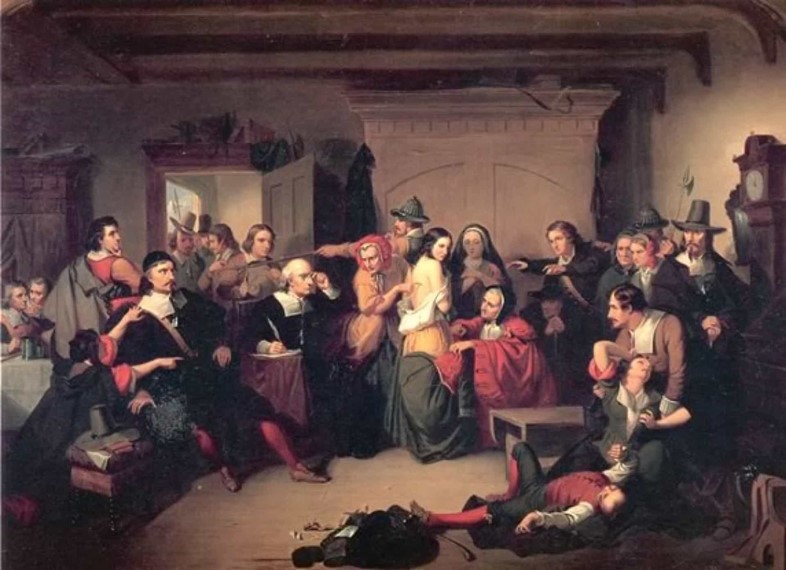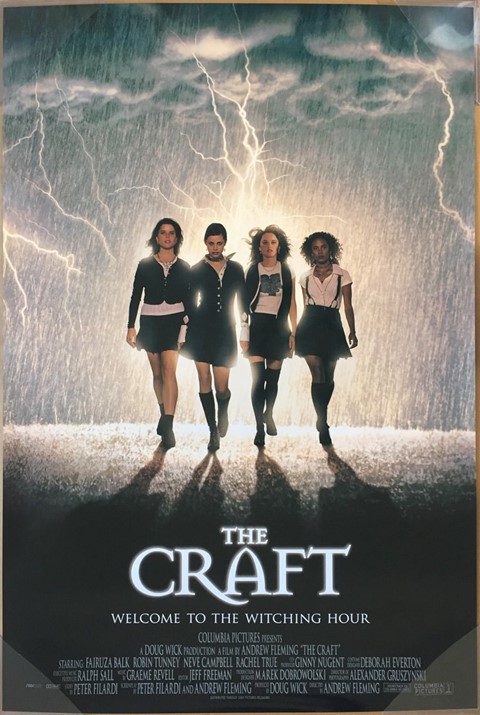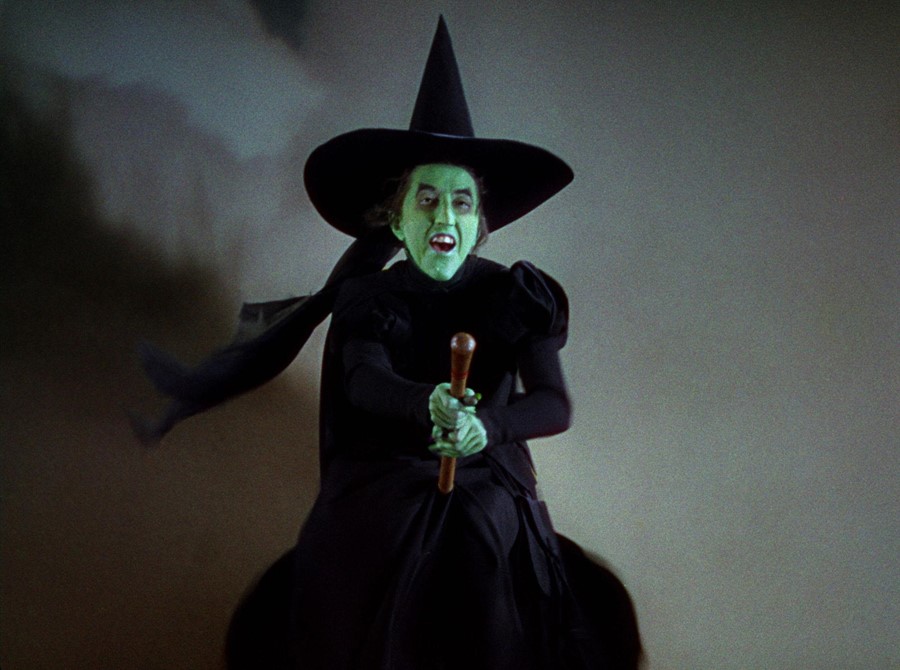From green faces and hook noses to Egyptian goddesses and Instagram witches
Welcome to Witch Week, a campaign dedicated to exploring how witchcraft, magick and beauty intersect. Discover photo stories shot featuring real witches in NYC, a modern reimagining of the witch, and one witch’s mission to get a tan, as well as in-depth features exploring herbology, science and alchemy, and male witches. Elsewhere, we’ve created four special covers to celebrate the campaign and our one year anniversary – something wicked this way comes.
Choosing a witch costume for Halloween isn’t as easy as it sounds. Do you go as Sarah Jessica Parker’s choker-wearing witch in Hocus Pocus, full plum lip liner and big bushy brows? Do you pump for full-blown Disney Maleficent, blood-red nails and purple hooded eyes? How about one of the angsty teens from 90s cult classic witch flick, The Craft, with full smokey eyes, dog collars, and tartan skirts? It’s a big old witchy pop-culture canon out there and an interesting one to not only enjoy, but unpick too.
Today, in 2019, dressing as a witch for Halloween isn’t as simple as: broom + big pointy hat + black cat = killer witch costume. Albeit small, the list above is a snapshot of Hollywood’s litany of witchy iterations that stretches far and wide, and goes some way to showcasing how often the role and identity of the witch has mutated throughout visual history. It’s fascinating when you stop and take stock. How did these trends and tropes even come about? Why did they occur when they did, and what do they say about how society at any given time contextualises the role of women, and of magic? Sexy, fearsome, grotesque, and gothic, we attempt to code break the representation of witches in popular culture.
It’s almost impossible to pinpoint who or when the first witch happened, or at least, was formally documented. There are mentions in the Bible, with one of the first recorded witches appearing in the book of Samuel (penned between 931 BC and 721 BC). She was the Witch of Endor, or the Endorian Sorceress, who summoned the spirit of prophet Samuel. She’s depicted in an 1857 painting wearing long, baggy robes that mask her eyes. Her aura is mysterious, ethereal – she stands bathed in the light of wisdom. No broomstick, no crooked nose. All lightness and grace.
In actuality, witches and witchcraft pre-date the Bible. Egyptian witchcraft is a good place to begin. There’s Isis, first mentioned in the Old Kingdom (2686–2181 BC). She was the Goddess of magic and wisdom, using her magic to protect children and heal the sick. In art, she’s seen wearing a sheath dress, and a headdress emblazoned with her name. Sometimes she’s seen wearing a crown of cow horns with a sun disk, or a crown with a cobra looming above her head. Isis is also at the root of those tyet amulets (aka ‘the knot of Isis’). The amulets signified the binary nature of life and were typically placed on mummies in the hope that Isis’s power would shield them from disease and evil. Now when you see any depiction of a generic ‘Ancient Egyptian goddesses’, you’ll see them wearing amulets to ward off bad vibes. Isis kickstarted the trend.
Another of history’s iconic witches was Alice Kyteler, Ireland’s first convicted witch. She was accused, in 1324, of having sex with a demon, though it’s not clear what evidence authorities actually had. What did she look like? In paintings, she’s shown with red hair parted down the middle, with a single plait at the back. She looks plain, a quiet enigma, like the silent girl in the back of the classroom. By some accounts, she was attractive and sophisticated, capable of manipulating men, including her four husbands who died from illnesses that allegedly originated from her spells.
When witch hysteria took hold in 1500s Europe, certain visual stereotypes also dug their heels in. Witches were transformed into old, hunched women, who were mostly poor. Any woman unlucky enough to be ‘crone-like’, snaggle-toothed, sunken cheeked or possessing a hairy lip were assumed to possess the ‘Evil Eye’. Throw in a cat and you’ve got iron-clad proof that said women was a witch. It was around the same time the broomstick emerged, having derived from the rumour that “witchy women applied psychoactive ointments on their crotches and then mounted the phallic mode of transportation”. The visuals are imbued with a sexist bias that would dog the depiction of the witch as sexually deviant and a hag well into modern times.
Women’s looks were key when witchcraft became a capital offence in Britain in 1563. Between then and 1750, around 200,000 witches were tortured, hung, or burnt at the stake in Western Europe, largely because of the way they looked. There was even a book focussing on how to identify and exterminate witches. Malleus Maleficarum, aka ‘Hammer of Witches’, directs witch-hunters to physically examine the female body for marks. Hair was to be shaved off to make it easier to spot ‘devil’s marks’. Examinations almost always uncovered a wart or mole that would justify a witch’s killing. The mole or wart was said to be the ‘witch’s teat’ from which she fed things like cats, frogs, newts, demon creatures. Hence, the stereotype of the warty witch.

Shakespeare’s Macbeth obviously fuelled this ugly stereotype. His Three Witches, dreamed up around 1606, prophesied Macbeth’s future and appear “wither’d and so wild in their attire” – according to Banquo. He also notes their facial hair: “You should be women, and yet your beards forbid me to interpret that you are so.” By all accounts, the three witches are hideous. They “don’t look like inhabitants of the earth”. This description no doubt informed the image of a witch you had as a child. Cauldron-stirring, toad-loving, cackling social pariahs, out to do no good.
The idea of witches and hideousness being synonymous was cemented during the notorious witch trials in Salem, Massachusetts in 1692. There, more than 200 people were accused of witchcraft, with 14 women executed by hanging. Judging by artists’ depictions, these women were plain-looking pilgrims with pasty faces who wore long dresses. Again, their bodies were examined because of the belief that the devil would make a pact with a witch by leaving a mark on their skin. (You can see this in the famous painting, “Examination of a Witch”, by Thompkins H. Matteson, which shows a young semi-nude girl being eye-ogled.)
One Salem witch was depicted in Thomas Satterwhite Noble’s painting “The Salem Martyr” (1869). She has thick eyebrows, milky skin, dark eyes, and flat dark hair. She’s a far cry from the seductive movie incarnation found in 1937’s Maid of Salem. Claudette Colbert stars as the sentenced witch (saved by a man!) who’s been given a Hollywood makeover, including trimmed eyebrows, perfectly curled hair under a white bonnet, and innocent eyes brimming with humanity. This, in contrast, is the picture of so-called American beauty and purity.
In the 20th century, there were two images of witches that dominated pop culture. They were either sultry and seductive (like the Queen of the goths, Morticia Addams) or green-faced and wart-ridden (like the Wicked Witch from The Wizard of Oz). The latter’s pointy black hat, too, became a mainstay on the Halloween costume circuit. Its roots and significance are disputed. Some say it arose from anti-Semitism in the 13th century, where Jews were forced to wear identifying pointed caps, which became associated with Satan-worship and black magic, acts of which Jews were accused. Some say the hat came from an anti-Quaker prejudice. Others claim its roots lie in alewife hats, a type of hat worn by women who home-brewed beer for sale.
That said, pop culture did slowly grow to accommodate every kind of witch you can think of. There was the smiling 1960s housewife in Bewitched, with her hair curlers and curiously doll-like face. There was Anjelica Huston’s grotesque Grand High Witch, vulture-like with wrinkles and a crooked nose in The Witches. Modern movie adaptations depicted them as goth schoolgirls and hippies on drugs, cranking up the sex-factor and often framing them as the alternative love interest. There was Sabrina, the innocent teen with blonde hair, blue eyes, and rosy complexion, and, of course, the aforementioned grungy schoolgirls of The Craft.
So what about 21st-century witches? Where are we now? If anything, today’s witches smartly subvert old stereotypes, as in The Love Witch. The movie’s titular witch is cloaked in pastels, with soft green eyeshadow, blood-red nails, soft blusher, and long black hair. Her palette is a nod to the rosy Technicolor movies from yesteryear, but it also parallels hazy Instagram filters that evoke the softness of 70s Polaroids. It’s knowingly pastiche – old school but whip-smart.

With Instagram in mind, that’s where you’ll find the aesthetic of the occult sprinkled over millennials’ accounts. Gabriela Herstik is a modern-day witch and author who regularly posts selfies holding tarot cards and daggers, pentagrams made of roses often looming behind her. Her head is half-shaved, leaving the rest of her black locks to fall down to her chunky choker. Like The Love Witch, it’s knowingly stylised, with a wink down the lens as she dons a Satanic Feminist t-shirt. This is her gallery – her space – of self-expression, where she can be different, powerful and accepted as a witch.
One Instagram beauty trend is the Mallen streak, which has become a sign of witchy otherness and alt girl beauty. You’ll know the look – which refers to a bolt of traditionally, but not always, white hair styled at someone’s hairline – see Billie Eilish. Billie’s look should truly be credited to Lily Munster and the Bride of Frankenstein.
Witches of 2019 might be harder to spot than your traditional Hollywood conjurer. Witches are much absorbed into the visual culture of the everyday now. There’s no one uniform: they wear Supreme box t-shirts, and black lipstick, they wear athleisure and baggy jeans. They’re you and they’re me, and they’re that lady on the tube and that man at the bus stop.
All of which is to say: the days of an all-encompassing witch stamp are gone. See Frances F. Denny’s portraits of modern witches in America as proof. Tall, small, young and old, like any clan they’re a diverse and eclectic community. Netflix’s smash hit series Sabrina The Teenage Witch is a nod to this new heritage that’s playing out as you read this. There’s no one costume or face that summarises the diverse and rich history and future of the witch. So this Halloween, ditch your broom, and do your homework, and failing that there’s always ‘sexy cat’.




